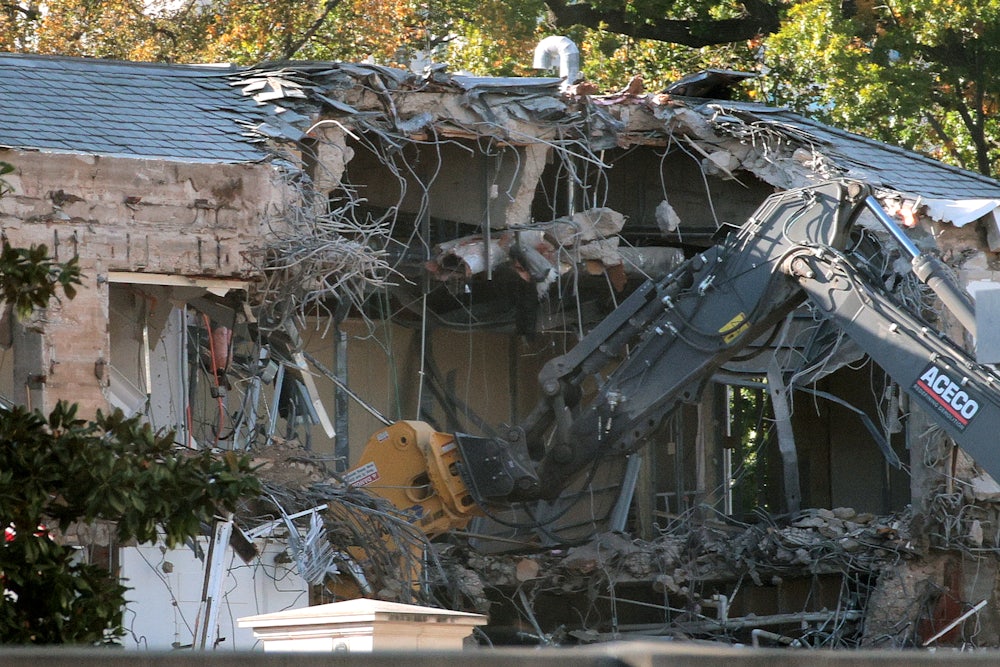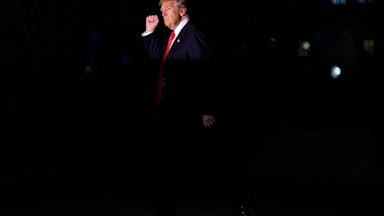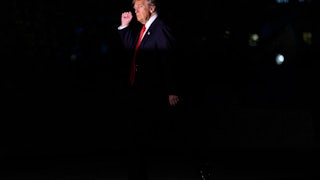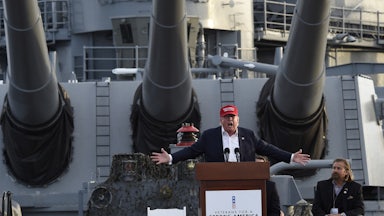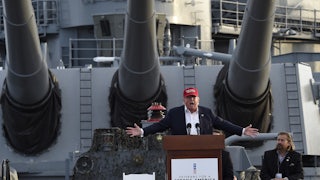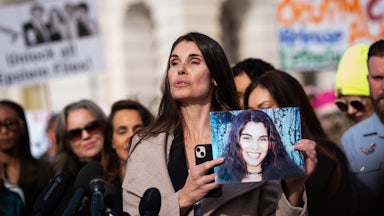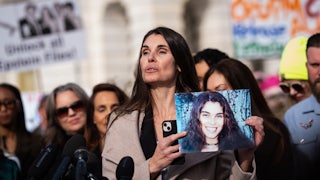It is hard to imagine a more fitting image of President Donald Trump’s second term than the photographs of the White House’s East Wing that became public this week. The first series of photos on Monday showed large holes torn in the wing’s exterior. By Tuesday, nearly the entire portion of the building had been destroyed.
The demolition is part of Trump’s planned construction of the White House State Ballroom, a gaudy 90,000-square-foot complex that will replace the East Wing. That space once held offices for the first lady’s staff, various other White House support personnel, and a guest entrance. Now it will feature a ballroom that fits 650 seated guests for Trump to fete and be feted by.
The raw spectacle of Trump tearing a hole in the White House to hang out with his rich friends is already a potent symbol of his presidency—almost ham-fisted in a way, as if it were drawn by a third-rate political cartoonist for a fourth-rate newspaper. At every level, the entire project may be the perfect summation of what his administration has been like for the country.
Trump’s building project is more or less illegal. The White House is both public property and a national historical site. Its welfare is overseen by the National Park Service, and any structural changes must be approved by the National Capital Planning Commission, or NCPC, which oversees federal public buildings in the nation’s capital more generally. Federal law requires the commission to approve plans for all federal buildings in the district, including the White House, in what can be a yearslong process of consultation and review.
The Trump administration has taken its usual approach to these hurdles. It did not bother submitting plans to the commission; it simply started gouging holes in the side of the building with an excavator. Will Scharf, the Trump-appointed head of the NCPC, claimed during a public meeting in September that no approval was necessary because the commission’s jurisdiction only covered construction, not demolition. He also happens to be the White House staff secretary and was a former personal lawyer for the president during his post-2020 legal troubles.
“Given the president’s history as a builder, and given the plans that we’ve seen publicly, I think this will be a tremendous addition to the White House complex, a sorely needed addition,” Scharf reportedly said at the meeting, with the usual mix of obsequiousness and prickliness that Trump appointees use when talking to the public. “I think any assertion that this commission should have been consulted earlier than it has been, or it will be, is simply false.”
Historical preservationists and architects are also aghast at Trump’s moves. The Society of Architectural Historians released a statement last week where it “expressed great concern” over the ballroom plans and urged the Trump administration to “follow a rigorous and deliberate design and review process.” The American Institute of Architects, which has previously advised White House construction efforts, urged the president in August to connect “each major decision to preservation, performance, safety, and access—safeguarding historic character while improving resilience and usability.” None of that appears to have happened.
A casual observer of the news might ask, “Hey, how is this happening while the government is shut down?” Trump circumvented Congress on funding by soliciting $200 million in private donations instead.* This was not a circumstance where millions of hardworking Americans spared a few bucks for a collection drive, either. Trump took in donations from his wealthy friends and allies, as well as major corporations with business before the administration.
But the literal demolition in progress is just one manifestation of the metaphoric wreckage of this presidency. At a fundraising dinner in the White House’s East Room—yes, the mansion already has an event space—earlier this month, Trump dined with oil barons, crypto evangelists, and tech oligarchs and regaled them with meandering tales about his presidential exploits. Among the topics were his illegal military strikes on civilian ships in the Caribbean, which his administration has justified by claiming that they were drug-smuggling vessels.
The prospect of killing innocent civilians did not seem to bother the president or those in attendance. “In fact, nobody wants to go fishing anymore,” Trump told laughing guests, according to The New York Times. “No one wants to do anything near the water. They might have a beautiful boat and they might as well get rid of their boat because they’re very nervous.”
Other illegalities abound. The Antideficiency Act, which dates back to the Reconstruction era, generally prohibits the executive branch from spending money unless authorized by Congress. Among its provisions is a ban on accepting “voluntary services,” meaning private funds or property, except in life-threatening situations. Schmoozing billionaires and foreign diplomats does not qualify, and violations of the ADA can theoretically lead to criminal charges.
In past administrations, this may have been cause for concern—and fodder for media outrage. Not so under Trump. The president has spent the last year ignoring black-letter federal law whenever it suits him, raising and spending federal funds without congressional permission, and treating the federal government as a personal extension of his private self. Trump staffed the Justice Department with his former defense lawyers and has now demanded $230 million in compensation for past investigations and prosecutions. Illegality and corruption are the standard, not the deviation, for this administration.
It is worth noting that the East Wing is not part of the original mansion. Its current structure dates back only to the Franklin D. Roosevelt administration, when it was built to cover a substantially sized bunker that was being installed underground in the midst of World War II. The actual mansion’s historic exterior remains intact, at least for now. Perhaps a giant neon sign is forthcoming.
Nor is the Trump administration incorrect to note that the White House has undergone significant renovations over the years. Roosevelt installed a swimming pool during his tenure. Harry Truman added a balcony on the second floor’s south face. Richard Nixon replaced part of a basement with a bowling alley. Barack Obama added a basketball court. These features tended to be additions instead of subtractions; with the exception of the balcony, they were also only semipermanent features.
After all, Trump is supposed to be a temporary occupant of the executive mansion. The American model of government draws a clear line between an elected official’s public responsibilities and private desires; the alternative is corruption and malfeasance. Nothing in the Constitution actually obligates Congress to provide for a place for the president to live while in the capital. Members of Congress and Supreme Court justices have no such official residences. But there is some practical good in giving the president a central location to live and work for the sake of security and convenience.
Trump has departed from these practices and principles to convert the White House into a personal palace of sorts. Shortly after his return, he paved over Jacqueline Kennedy’s Rose Garden outside the West Wing to create a patio space resembling the ones at his Mar-a-Lago resort in Florida. The “Rose Garden Club,” as the administration now terms it, is an entertaining space where government officials, private citizens, and other favored supplicants and courtiers can be fed and entertained by the White House staff alongside Trump. (For those keeping track, that means Trump is adding two event spaces to a mansion that already had plenty of them.)
Even the Oval Office itself, which is always tailored to a president’s tastes, is now covered in ugly gilded ornamentation like the rest of his business properties. During his first term, Trump often traveled to the properties he privately owned—Mar-a-Lago, his Bedminster golf course, the Old Post Office hotel in downtown D.C. that he later sold—to blur the line between his public and private life. Now that line has been thoroughly erased. Few things could symbolize the shift more clearly than transforming the White House into a private resort of sorts, demolishing and rebuilding it on a whim.
The symbolic message is inescapable. Trump appears to think that he acquired the federal government in a hostile takeover on election night last year and that he is now the Boss of America. Public property like the White House is now part of his private portfolio. The federal civil service, stripped of for-cause firing protections and nonpartisanship guidelines, is functionally indistinguishable from the at-will employees of the Trump Organization.
The White House itself has been through worse than what Trump has doled out so far. British soldiers burned it down in 1814; the whole thing nearly collapsed in the late 1940s. Nearly 150 years of structural additions, poor maintenance, and continuous use had left the wooden structure and the brick masonry in dire condition. “The White House wouldn’t pass any building code in America,” W.E. Reynolds, the commissioner of public buildings in Washington, D.C., told Congress in April 1948. “I’m convinced a portion of the second floor is staying up purely from habit.”
Presidents and White House personnel knew for decades that the building was aging poorly. After Reynolds’s testimony, Truman commissioned a more extensive survey that found the building was in danger of imminent collapse. In the winter of 1948, the president announced that he would be vacating the executive mansion for a few years so that it could be completely rebuilt from the inside out.
In addition to the physical dangers, symbolism was on everyone’s mind. Truman decided against revealing the extent of the White House’s deterioration until after the 1948 election, or his lengthy departure from it, to avoid the images that it would conjure in the public’s mind about his presidency. The White House’s exterior was also kept intact, even though the building was completely gutted and rebuilt on the inside, to avoid unflattering views of a national icon.
Public buildings, after all, tend to reflect and represent a nation’s values and ideals. Many of Washington’s most prominent buildings are in the neoclassical style to evoke Greco-Roman democratic virtues instead of the aristocratic and monarchical aesthetics of European royal residences—or the gaudy, golden spaces occupied by preening dictatorships. The Capitol’s austere marble and the White House’s blank masonry are in sharp republican contrast to the gilded splendor of Versailles or Buckingham Palace.
Speaking of the Capitol, this is, by my count, the second seat of the federal branches of government that has been damaged over the last decade at Trump’s behest. Pro-Trump insurrectionists caused $30 million in damage to the U.S. Capitol on January 6, 2021, when they stormed it in an attempt to stop the electoral vote count for the 2020 presidential election. God only knows what the president and his allies have in store for the Supreme Court building over the next few years.
For now, Trump’s priority is the ballroom he’s long demanded. In a sense, I can’t really blame him. It would be the perfect monument to his presidency. Nothing else could capture his arrogant sense of personal ownership over public goods and services; his blithe disregard for legal and procedural constraints; his zealous encouragement of oligarchy, corruption, and personalist rule; his reckless desecration of national sites; his utter lack of basic American civic beliefs; and his self-absorbed priorities.
The good news is that the White House, for all its historical value and symbolic potency, is just a building. The next Democratic president can happily demolish whatever ballroom Trump manages to construct over it. The East Wing was built once before and can be rebuilt again. The patio that now covers the Rose Garden can be dug up, filled in with healthy soil, and replanted to bloom once more. If only our national values and institutions could be restored so easily.
* This post originally misidentified the amount of money solicited.
